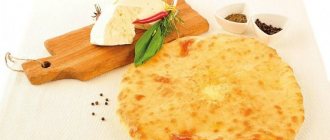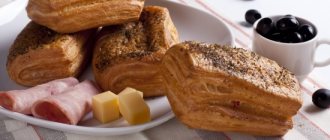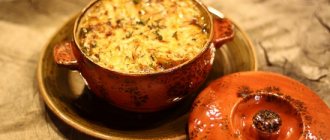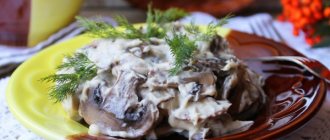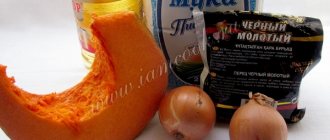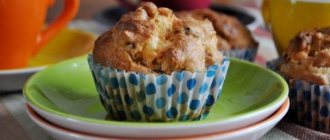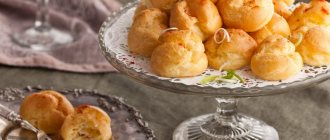Blue cheese: names of types and varieties
According to legend, blue cheese owes its formation to chance. In the town of Roquefort, about 2000 years ago, a French shepherd forgot his lunch - bread, cheese and water - in a cave. After a month, the loss was found and for some reason (possibly due to the lack of other food and severe hunger), the man ate the stale food. The cheese, covered with bluish mold, had a salty, spicy taste and was extremely liked by the shepherd. The inhabitants of his village appreciated the shepherd's discovery and began to specially put the prepared cheeses in the caves. This is how Roquefort, the first blue cheese, appeared. In the 15th century, cheesemakers in this province received permission from the king to produce this original cheese. Today, the aromatic product with a wonderful nutty flavor is famous all over the world.
Of course, over the past centuries, the technology for making cheese has changed, as has the geographic distribution of the delicacy. Today, blue cheeses are made not only in France, but also in Italy and Great Britain.
What is the name of blue cheese and its many varieties?
The “names” of the product largely depend on the color of the mold used in the manufacturing process.
Cheese with white mold
This product is clearly recognizable from the variety of numerous “brothers” on store shelves. A fluffy white mold is visible on top of the product. Cheeses smell of withered grass, fungi and moss - this smell seems to immerse the consumer in the beauty of the autumn forest.
Varieties of cheese with white mold are represented by the names Boulette-daven, Brie, Neuchatel and Camembert.
- Boulet-daven. The product owes its name to the French town of Aven, after which the cheese is named. It is made in the form of original triangles weighing about 300 grams, flavored with spices. The cheese matures for 2-3 months.
- Bree. The most popular cheese with white mold. It has long been considered the favorite dessert of many French kings. Young cheese has a soft and delicate taste, older cheese has a spicy taste.
- Neuchatel. Normandy cheese, covered with a dense crust with clearly visible mold on the surface. It has a bright mushroom taste.
- Camembert. A type of fatty cheese that ripens from September to May (the product does not like heat). Made from cow's milk. Mushroom notes are easily distinguishable in the delicate creamy taste.
With red mold
Another interesting subtype of savory delicacy is products with red, burgundy or orange mold.
The cheese gets its unusual shade as a result of washing technology during the ripening period:
- Camembert is dipped in cider. As a result, the product is covered not with white, but with red mold, and the taste of the cheese is much sharper than the classic version.
- German Limburgish. The aged cheese is tied with reeds and then irrigated with water to which the dye annatto has been added.
- Epuas. They “treat” you with Burgundy vodka, which is based on red grape varieties.
Blue cheese
Blue mold has only recently been discovered. It is approved for official use in some products, including cheese.
The most popular types of blue cheeses:
- Roquefort. Yes, yes, the same one that languished in the cave for so long. To this day, it is sent to mature in special caves with the required level of humidity and temperature. Rye bread is involved in the formation of blue mold, and so that it appears not only on the outside, but also inside the cheese, it is pierced with needles.
- Gorgonzola. Italian cheese made from cow's milk. The cooking technology is reminiscent of Roquefort, but Gorgonzola matures longer - 4 months, not 3, like its French counterpart. The taste of the cheese is piquant and pungent.
- Dorblu. The cheese recipe was created at the beginning of the last century in Germany (by the way, the recipe is kept secret to this day). Unlike previous options, this cheese has a milder taste.
- Stilton. English cheese made from cow's milk. For complete readiness, it is aged for 9 weeks. It is considered the budget equivalent of Dorblu.
- Danablu. Relatively young from the point of view of creating a recipe, cheese. It matures for 3 months and exists as a budget substitute for Roquefort. Unlike the latter, Danablu has a more salty taste.
Homemade Brie cheese. Blue Brie cheese recipe
Brie cheese is one of the most popular soft French cheeses with cultivated mold.
Today, people try to copy his recipe everywhere and produce it in many countries around the world.
Brie blue cheese heads have the shape of a flat, thin pie with a diameter of approximately 35 to 50 cm, a height of 2.5-5 cm (sizes vary by variety and manufacturer).
The head is covered with a crust, which, depending on the type of mold, has a lime-white or reddish-brown coating.
The cheese dough itself is creamy in color, it is very soft, spreads easily and has a faint ammonia aroma (especially in overripe cheese).
Brie cheese, made from raw milk, typically has a stronger tangy flavor that some people associate with roasted hazelnuts.
The fat content of brie cheese varies between 40-50%. Calorie content is about 330 kcal per 100 g.
It won't be difficult to buy a piece of brie cheese at the store, but with a little effort and desire, it is quite possible to make brie at home.
The preparation of soft cheeses with white mold is considered technologically simpler than, for example, hard or semi-hard varieties of the product.
No additional pressing, prolonged salting or other manipulations.
Ingredients for Brie cheese recipe:
- whole milk - 8 l
- mesophilic lactic acid cultures - 1/4 teaspoon
- white penicillin mold powder - 1/8 teaspoon
- calcium chloride - 1/4 teaspoon
- liquid rennet starter – 1/4 teaspoon
- canning salt or coarse salt - four teaspoons
You can buy starter for Brie cheese in the online store with delivery by Russian post or courier service.
How to make Brie cheese at home:
Sterilize all kitchen utensils and utensils you will use (spoons, pots, measuring containers, etc.). Thoroughly disinfect the work surfaces on which you will place kitchen utensils with hot soapy water, then with clean water.
Place the pan with milk in a hot water bath. Stirring lightly, heat the milk over low heat to 31°C. Remove the pan from the stove.
Place the lactic acid cultures and penicillin mold on the surface of the milk and let it sit for about 5 minutes to curdle. Using a slotted spoon, move the cultures to the bottom in a downward motion without agitating the milk.
Dissolve calcium chloride in 1/4 cup (50 milliliters) of cold water and add it to the milk in a downward motion.
Dilute the rennet starter with 1/4 cup (50 milliliters) of cold water and add to the milk.
Using a top-to-bottom motion, move the starter to the bottom and stir the mixture well. Cover the milk with a towel at room temperature for about 1 hour 30 minutes.
Insert the long, flat blade of the cheese knife into the curd at a 30° angle and slowly lift it towards the surface of the curd.
If the curd splits or breaks, you can cut it. If the break is uneven and insignificant, leave the curd for another 5-10 minutes and then try to cut again.
Using a long-bladed knife and a slotted spoon, cut the cottage cheese in the pan into 2.5 cm cubes. To do this, first cut it vertically into 2.5 cm wide strips.
Next, use a knife to cut into the same strips, but perpendicular to the first ones, so that you get squares on the surface of the cottage cheese.
Then, using a slotted spoon, cut off the top layer of cottage cheese to a depth of 2.5 cm so that you get cubes. Cut the remaining cottage cheese in the same way. Leave the curd for 5 minutes to separate the whey.
Stir the cottage cheese with a slotted spoon for 10 minutes until the pieces of cottage cheese begin to shrink in size and their edges are rounded. Leave the curd to settle.
Prepare a container for drying cheese. You will need a large (30L) plastic (not colored) food storage container with a lid. Place a baking rack inside the container and cover it with a large white plastic cutting board. Place a cheese mat or bamboo sushi mat on the board (treat before use).
Use a cup to drain excess whey from the pan until it reaches the surface of the curd mass. Use a slotted spoon to place the curd mixture into special cheese molds with holes 20 cm in diameter.
Place the molds in a container for drying the cheese and leave the curd to separate the whey for 2 hours, then turn it over and let it out for another 2 hours.
Close the container with a lid and leave the curd to separate the whey overnight at room temperature.
Turn the cottage cheese over in the morning and leave for another 2 hours. The total whey separation time will be approximately 24 hours. Remove the molds with cottage cheese from the container and replace the mat with a clean one.
Sprinkle one side of the curd mass with 1 teaspoon of salt, then turn it over, add salt again and place it in a container. Close it with a lid.
Leave to ripen at 10-13 °C and 90% humidity. Turn daily, removing any excess whey from the bottom of the container with a paper towel.
After 1 week of ripening, white mold will begin to appear on the surface of the cheese.
Continue turning the cheese daily.
It will be completely covered with mold in 12 days. Pack it in paper and put it back to ripen.
After a week the cheese will become soft.
Will be ready to eat after 4-5 weeks of ripening.
Homemade blue cheese Brie can be stored in the refrigerator for up to 6 weeks.
Previous article: Baozi with tofu vegetarian recipe Next article: Homemade cheese. Homemade cheese recipe
What are the benefits and harms of the product?
It turns out that cheese with penicillin is not only tasty, but also healthy and here’s why:
- Restores the acid-base balance of the oral cavity. Thereby eliminating unpleasant odors from the mouth.
- Helps remove toxins from the body.
- Protects skin from the harmful effects of UV radiation. In addition, “moldy” cheese is an effective prevention of wrinkles.
- Fights gastrointestinal disorders.
Blue cheese is considered harmful for:
- pregnant women;
- little children;
- patients diagnosed with enterocolitis, ulcer or pancreatitis;
- people with pathologies of the endocrine system.
Description of preparation:
Do you like blue cheese and want to make it instead of buying it from the store? I'll tell you how to make blue cheese at home. The recipe for making blue cheese at home is simple, but it requires attention, time and patience. Well, following the rules, which I will try to explain clearly in the recipe. So let's get started. 1. Heat the milk to a temperature of 32-35 degrees. 2. Carefully collect the mold from half of the store-bought blue cheese and stir it into 0.5 cups of warm milk. Let stand for about an hour. 3. Grind pepsin tablets into powder and dissolve in 100 ml of water. 4. Add the mold solution and the tablet solution to the milk and stir well. Cover and place in a warm place for about 1 hour. 5. During this time, the milk is fermented and a clot similar to jelly should form. The serum should be yellowish in color. Cut the curd into small pieces. Be sure to check whether the clot has broken closer to the bottom of the pan. 6. Leave for 15 minutes so that the cheese pieces settle to the bottom. 7. Use a slotted spoon to collect the cheese pieces and place them in a colander or in a cheese mold with holes. 8. Do not press the cheese with anything; the whey should drain on its own within about 12 hours. During this time, you need to carefully turn the piece over several times. 9. After 12 hours, remove the cheese from the mold, wipe with salt and leave to dry at room temperature for another 12 hours. In order for the cheese to dry, it is laid out on a special drainage lid with holes. 10. Take mold from the remaining piece of store-bought cheese and dilute it in 50 ml of warm milk. Stir and leave for an hour. 11. Pierce the dried cheese with sterile thick knitting needles or wooden sticks and pour mold solution into the holes formed. You can do this with a syringe, but make the holes wider than the thickness of the needle. 12. Take two sterile ones. plastic jars. One is smaller, the other is slightly larger and has a lid. In a smaller jar you need to make holes, the more often the better. We put our cheese in it. Pour a teaspoon of boiled water into a larger jar. 13. Place the jar of cheese in a jar of water and cover with a lid. Do not close hermetically! The cheese should sit at room temperature for about 7-10 days. During this time, mold should grow on it. The cheese must be turned over every 2 days. Well, the cheese is ready, you can try it, or you can wrap it in parchment and let it ripen in the refrigerator for another week. May everything work out for you.
Nalistniki with cheese
How to eat blue cheese correctly
Blue cheese is a delicacy widely used in many cuisines around the world. The product will be an excellent treat, either on its own or in tandem with other products.
Cheese goes best with:
- with fruits. The cheese is served with figs, pears, and apples;
- with nuts. The cheese gets along well with walnuts or almonds;
- with wine. Please note that each type of cheese is suitable for a specific alcoholic drink. So, for Roquefort you should choose sweetish wines such as port or Sauternes. These drinks will highlight the harsh taste of the delicacy. Soft cheeses (Brie or Camembert) go well with sparkling wines.
What is mold?
Mold is a type of fungus that produces spores. They are transported by air, insects, and water, and can be found throughout the environment, including in your refrigerator, although they grow best in warm, humid conditions (1).
Mold is a sign of spoilage in most foods. It tends to be fluffy and has green, white, black, blue or gray undertones.
When mold begins to grow, it is usually visible on the surface of the food - although its roots can go very deep. It changes the appearance and smell of food, creating a sour or unpleasant odor (1).
Although mold is generally dangerous to eat, some types are used in cheese production to add flavor and texture. These species are absolutely safe for consumption.
Mold is a fungus that is characterized by fluffy, colorful spots. Although it is usually a sign of spoilage, some types are used to make certain cheeses.
Recipes with blue cheese
The delicacy with mold is often used in the preparation of various dishes in many countries around the world. You can prepare delicacies from it in your own kitchen:
Salad
Ingredients:
- chicken fillet – 1 pc.;
- avocado – 1 pc.;
- bacon – 150 g;
- cherry tomatoes – 10 pcs.;
- Roquefort – 150 g;
- eggs (quail) – 4 pcs.;
- salad (leaves) – 5 pcs.
Preparation:
- Fry the bacon and sauté the fillet in the same oil.
- Cut avocado, eggs and tomatoes into slices.
- Place the ingredients in a circle: lettuce, eggs, cheese, bacon and chicken, avocado and finally tomato.
- Pour olive oil over the salad.
Sauce
Ingredients:
- Roquefort – 100 g;
- cream – 200 ml;
- black pepper - to taste.
Valence cheese recipe
- The milk is heated to a temperature of 30 - 32 degrees, kept for 15 minutes and cooled to a temperature of 20 -23 degrees. Under these conditions, the milk begins to curdle. Rennet is added to speed up the process.
- The process of coagulating the raw material lasts 10–11 hours with regular stirring. The resulting clot is cut into layers and placed in molds for pressing.
- To remove all the liquid from the dough, the mold is placed on trays with drainage. The cheese pressing process lasts 12 hours.
- There is no need to turn over so as not to disturb the shape of the cheese.
- Then the dough is placed in a chamber with a temperature of 10 - 12 degrees. The heads will finally form in them.
- Next, the cheese is removed from the containers, rubbed with salt and ash, and the mold is distributed.
- The finished cheese is sent to the drying room. It maintains a constant temperature of 18 - 20 degrees, humidity 80 percent.
- In these rooms, the cheese matures for 3 to 5 days. The finished heads should be evenly covered with ash and mold.

